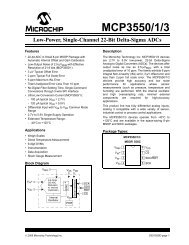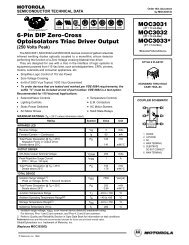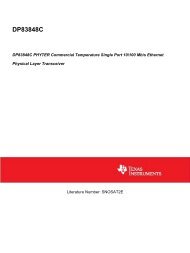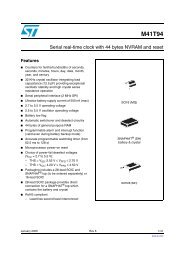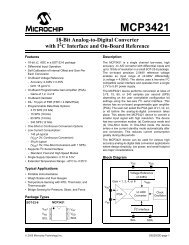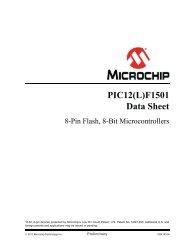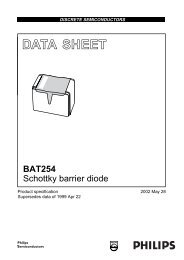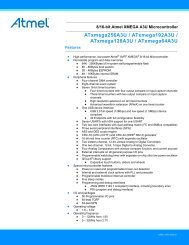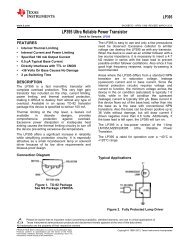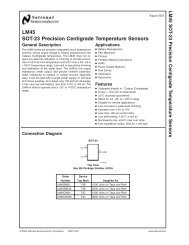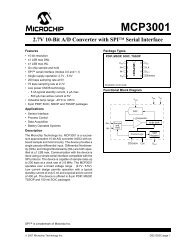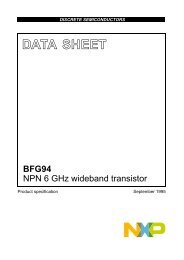pic24fj128ga010 family - Microchip
pic24fj128ga010 family - Microchip
pic24fj128ga010 family - Microchip
Create successful ePaper yourself
Turn your PDF publications into a flip-book with our unique Google optimized e-Paper software.
PIC24FJ128GA010 FAMILY11.0 TIMER2/3 AND TIMER4/5Note:The Timer2/3 and Timer4/5 modules are 32-bit timers,which can also be configured as four independent 16-bittimers with selectable operating modes.As a 32-bit timer, Timer2/3 and Timer4/5 operate inthree modes:• Two independent 16-bit timers (Timer2 andTimer3) with all 16-bit operating modes• Single 32-bit Timer• Single 32-bit Synchronous CounterThey also support these features:• Timer gate operation• Selectable prescaler settings• Timer operation during Idle and Sleep modes• Interrupt on a 32-bit Period register match• ADC Event Trigger (Timer4/5 only)Individually, all four of the 16-bit timers can function assynchronous timers or counters. They also offer thefeatures listed above, except for the ADC EventTrigger; this is implemented only with Timer5. Theoperating modes and enabled features are determinedby setting the appropriate bit(s) in the T2CON, T3CON,T4CON and T5CON registers. T2CON and T4CON areshown in generic form in Register 11-1; T3CON andT5CON are shown in Register 11-2.For 32-bit timer/counter operation, Timer2 and Timer4are the least significant word; Timer3 and Timer4 arethe most significant word of the 32-bit timers.Note:This data sheet summarizes the featuresof this group of PIC24F devices. It is notintended to be a comprehensive referencesource. Refer to Section 14. “Timers”(DS39704) in the “PIC24F FamilyReference Manual” for more information.For 32-bit operation, T3CON and T5CONcontrol bits are ignored. Only T2CON andT4CON control bits are used for setup andcontrol. Timer2 and Timer4 clock and gateinputs are utilized for the 32-bit timermodules, but an interrupt is generated withthe Timer3 or Timer5 interrupt flags.To configure Timer2/3 or Timer4/5 for 32-bit operation:1. Set the T32 bit (T2CON or T4CON = 1).2. Select the prescaler ratio for Timer2 or Timer4using the TCKPS1:TCKPS0 bits.3. Set the Clock and Gating modes using the TCSand TGATE bits.4. Load the timer period value. PR3 (or PR5) willcontain the most significant word of the value,while PR2 (or PR4) contains the least significantword.5. If interrupts are required, set the interrupt enablebit, T3IE or T5IE; use the priority bits,T3IP2:T3IP0 or T5IP2:T5IP0, to set the interruptpriority. Note that while Timer2 or Timer4 controlsthe timer, the interrupt appears as a Timer3or Timer5 interrupt.6. Set the TON bit (= 1).The timer value at any point is stored in the registerpair, TMR3:TMR2 (or TMR5:TMR4). TMR3 (TMR5)always contains the most significant word of the count,while TMR2 (TMR4) contains the least significant word.To configure any of the timers for individual 16-bitoperation:1. Clear the T32 bit corresponding to that timer(T2CON for Timer2 and Timer3 orT4CON for Timer4 and Timer5).2. Select the timer prescaler ratio using theTCKPS1:TCKPS0 bits.3. Set the Clock and Gating modes using the TCSand TGATE bits.4. Load the timer period value into the PRx register.5. If interrupts are required, set the interrupt enablebit, TxIE; use the priority bits, TxIP2:TxIP0, toset the interrupt priority.6. Set the TON bit (TxCON = 1).© 2009 <strong>Microchip</strong> Technology Inc. DS39747E-page 107



